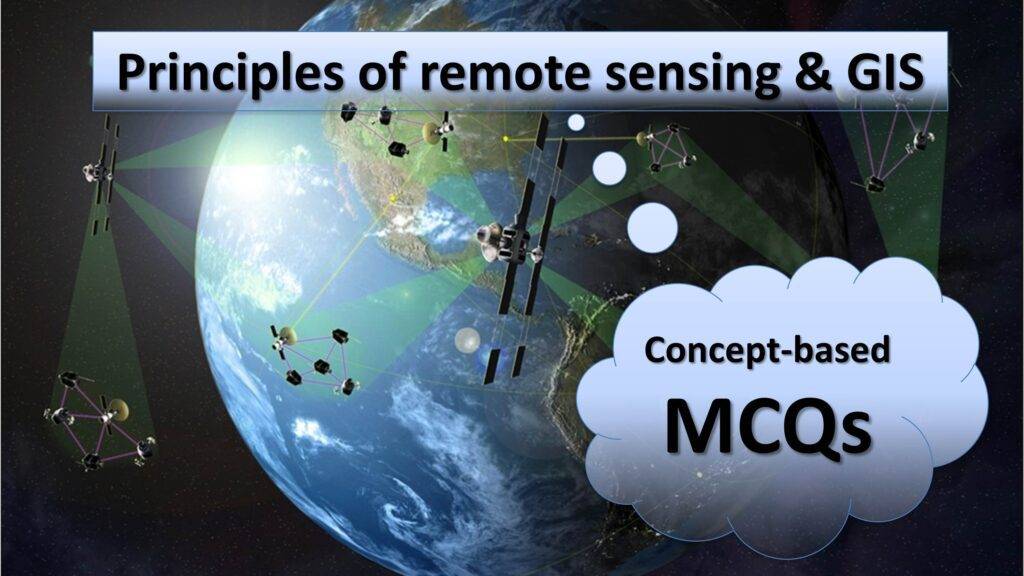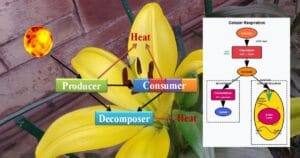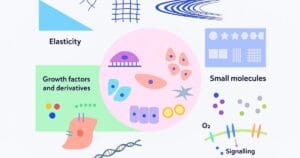
Welcome to the COMPETITIVE EXAM MCQs SERIES of ENVIRONMENTAL SCIENCE for UGC-NET/JRF, SLET, GATE, and other entrance tests – Principles of remote sensing and GIS.
Syllabus outline
- Definition, scope, and significance of remote sensing and GIS.
- Historical development and evolution of these technologies.
- Electromagnetic spectrum and its interaction with Earth’s surface.
- Remote sensing platforms and sensors (e.g. satellites, aerial photography, and sensors’ characteristics).
- Visual interpretation and digital image processing.
- Image elements: tone, colour, texture, pattern, and size.
- Types of remote sensing data (e.g. multispectral, hyperspectral, thermal, and radar).
- Data acquisition techniques, spatial and spectral resolutions.
- Image enhancement, transformation, and classification techniques.
- Change detection, image fusion, and image compression.
- Definition and components of GIS (e.g. data, hardware, software, and people)
- Spatial data models: vector and raster, and their applications.
- Data sources: primary and secondary data, remote sensing, and GPS.
- Data input methods (e.g. digitization, scanning, GPS, and data conversion).
- Spatial data querying, analysis, and modelling.
- Buffering, overlay, network analysis, and spatial interpolation.
- Map elements, scale, projection, and coordinate systems.
- Principles of map design, thematic maps, and cartographic visualization.
- Land use/land cover mapping, environmental monitoring, urban planning, disaster management, agriculture, forestry, and natural resource management.
This quiz contains the concept-based most frequently asked 25 MCQs of “Principles of remote sensing and GIS“. Each question has a single correct/most appropriate answer.
1. Which electromagnetic spectrum region is often used for thermal infrared remote sensing?
a) Longwave Infrared
b) Shortwave Infrared
c) Near Infrared
d) Visible
2. Which GIS operation involves creating a new dataset by merging two or more datasets?
a) Network analysis
b) Clipping
c) Interpolation
d) Buffering
3. Which GIS operation can be useful to create a continuous surface from a set of discrete points with associated values?
a) Buffering
b) Interpolation
c) Geocoding
d) Clipping
4. What does the term temporal resolution refer to in remote sensing?
a) The ability to distinguish between different types of surfaces
b) The accuracy of spatial measurements
c) The ability to detect small changes in wavelength
d) The frequency of image acquisition over time
5. What is the primary advantage of synthetic aperture radar remote sensing?
a) Multispectral capability
b) High spatial resolution
c) Low cost
d) All-weather capability
6. In remote sensing, what is the purpose of radiometric calibration?
a) To correct for geometric distortions in the image
b) To convert digital numbers to physical units of measurement
c) To enhance the contrast of the image
d) To remove noise from the image
7. Which GIS analysis technique is used to calculate the shortest path between two points considering the cost or impedance along the way?
a) Buffering
b) Geocoding
c) Network analysis
d) Overlay
8. What is the primary purpose of geocoding in GIS?
a) Creating topographic maps
b) Capturing remote sensing imagery
c) Aligning geographic data to a known coordinate system
d) Representing elevation data
9. Assertion (A): The spatial resolution of a remote sensing image is determined by the size of individual pixels.
Reasoning (R): Higher spatial resolution means that each pixel covers a larger area on the ground.
a) Both A and R are true, but R does not explain A correctly.
b) The A is false, but the R is true.
c) Both A and R are true, and the R is the correct explanation of the A.
d) The A is true, but the R is false.
10. Which remote sensing platform orbits the Earth at a relatively low altitude and provides high spatial resolution imagery?
a) Polar-orbiting satellite
b) UAV (drone)
c) High-altitude balloon
d) Geostationary satellite
11. Assertion (A): Active remote sensing uses emitted energy to measure the properties of objects or surfaces.
Reasoning (R): Active sensors rely on the detection of naturally emitted energy from objects.
a) The A is true, but the R is false.
b) Both A and R are true, and the R is the correct explanation of the A.
c) The A is false, but the R is true.
d) Both A and R are true, but R does not explain A correctly.
12. Assertion (A): Remote sensing image enhancement improves the spatial resolution of an image.
Reasoning (R): Image enhancement techniques are used to improve the visual quality of an image by modifying its appearance.
a) The A is true, but the R is false.
b) Both A and R are true, and the R is the correct explanation of the A.
c) Both A and R are true, but R does not explain A correctly.
d) The A is false, but the R is true.
13. Assertion (A): Buffering is a GIS operation that creates a smooth transition zone around geographic features.
Reasoning (R): Buffering involves intersecting multiple layers to create a new layer.
a) The A is false, but the R is true.
b) Both A and R are true, and the R is the correct explanation of the A.
c) The A is true, but the R is false.
d) Both A and R are true, but R does not explain A correctly.
14. Which GIS analysis technique can calculate the area within a specified distance of a feature?
a) Geocoding
b) Overlay
c) Buffering
d) Network analysis
15. In GIS, what does the term attribute data refer to?
a) The shape and size of geographic features
b) The descriptive information associated with geographic features
c) The spatial coordinates of geographic features
d) The visual representation of geographic features
16. Which remote sensing sensor is commonly used for capturing high-resolution aerial imagery?
a) LiDAR
b) MODIS
c) Hyperion
d) Landsat
17. Assertion (A): GIS overlay analysis combines spatial data layers to derive new information.
Reasoning (R): Overlay analysis is commonly used to perform topological operations on vector data.
a) Both A and R are true, but R does not explain A correctly.
b) The A is true, but the R is false.
c) The A is false, but the R is true.
d) Both A and R are true, and the R is the correct explanation of the A.
18. Assertion (A): Remote sensing provides data about the Earth’s surface using sensors located on satellites, aircraft, or other platforms.
Reasoning (R): Remote sensing can capture detailed information about underground geological features.
a) The A is true, but the R is false.
b) Both A and R are true, but R does not explain A correctly.
c) Both A and R are true, and the R is the correct explanation of the A.
d) The A is false, but the R is true.
19. What is the primary purpose of orthorectification in remote sensing?
a) Adjusting the brightness and contrast of an image
b) Correcting geometric distortions in the image
c) Removing noise from the image
d) Enhancing image contrast
20. Which GIS data model represents the real world using discrete objects and their characteristics?
a) Tabular data model
b) Vector data model
c) Raster data model
d) Image data model
21. Assertion (A): Image classification is a process in remote sensing that categorizes pixels in an image into different land cover classes.
Reasoning (R): Image classification is a supervised learning algorithm.
a) Both A and R are true, and the R is the correct explanation of the A.
b) The A is true, but the R is false.
c) Both A and R are true, but R does not explain A correctly.
d) The A is false, but the R is true.
22. Assertion (A): Light Detection and Ranging (LiDAR) remote sensing uses laser pulses to measure distances.
Reasoning (R): LiDAR sensors rely on the passive reception of reflected sunlight.
a) The A is true, but the R is false.
b) The A is false, but the R is true.
c) Both A and R are true, and the R is the correct explanation of the A.
d) Both A and R are true, but R does not explain A correctly.
23. Assertion (A): Hyperspectral remote sensing captures a narrow range of electromagnetic spectrum bands.
Reasoning (R): Hyperspectral sensors are useful for detecting thermal radiation.
a) Both A and R are true, and the R is the correct explanation of the A.
b) The A is true, but the R is false.
c) Both A and R are true, but R does not explain A correctly.
d) The A is false, but the R is true.
24. In GIS, what is the function of a topology rule?
a) To define the spatial extent of a dataset
b) To specify the coordinate system of a map
c) To categorize features based on attributes
d) To enforce spatial relationships between features
25. Which type of data analysis involves examining the relationships and patterns between different spatial datasets?
a) Spatial statistics
b) Spatial interpolation
c) Georeferencing
d) Geostatistics
Previous: Agro-climatic zones of India
Next: Environmental education and awareness
References
- Lillesand, T. M., Kiefer, R. W., & Chipman, J. W. (2014) Remote Sensing and Image Interpretation, John Wiley & Sons, 7th edition.
- Lohani, B., & Singh, S. (2019) Fundamentals of Remote Sensing and GIS, PHI Learning Pvt. Ltd., 1st edition.
- M. Anji Reddy (2016) Principles of Geographic Information Systems and Remote Sensing, BS Publications, 4th edition.

